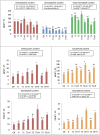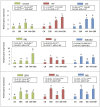Pre-sowing Seed Treatment with 24-Epibrassinolide Ameliorates Pesticide Stress in Brassica juncea L. through the Modulation of Stress Markers
- PMID: 27853460
- PMCID: PMC5089990
- DOI: 10.3389/fpls.2016.01569
Pre-sowing Seed Treatment with 24-Epibrassinolide Ameliorates Pesticide Stress in Brassica juncea L. through the Modulation of Stress Markers
Abstract
The present experiment was designed to assess the effects of seed soaking with 24-epibrassinolide (EBR) on the physiology of Brassica juncea L. seedlings grown under imidacloprid (IMI) toxicity. Application of EBR increased the length of seedlings, dry weight, and pigment contents, polyphenols, total phenols, and organic acids under IMI toxicity. The expression of genes coding key enzymes of pigment, phenols, polyphenols, and organic acid biosynthetic pathways was also studied including CHLASE (chlorophyllase), PSY (phytoene synthase), CHS (chalcone synthase) and PAL (phenylalanine ammonialyase), CS (citrate synthase), SUCLG1 (succinyl Co-A ligase,), SDH (succinate dehydrogenase), FH (fumarate hydratase), MS (malate synthase). Multiple linear regression (MLR) analysis revealed that IMI application regressed negatively on seedling length, dry weight and total chlorophyll content. However, EBR seed treatment regressed positively on all the parameters studied. Moreover, interaction between IMI and EBR showed positive regression for growth parameters, content of pigments, total polyphenol, total phenol and malate, and expression of PSY and PAL. Negative interactions were noticed for the contents of fumarate, succinate and citrate, and expression of CHS and all genes studied related to organic acid metabolism. In conclusion, EBR enhanced the growth and contents of all studied metabolites by regulating the gene expression of B. juncea seedlings under IMI stress.
Keywords: GC-MS; HPLC; brassinosteroids; mustard; phenylalanine ammonialyase; pigments; total phenols.
Figures


References
-
- Ahammed G. J., Zhou Y. H., Xia X. J., Mao W. H., Shi K., Yu J. Q. (2013). Brassinosteroid regulates secondary metabolism in tomato towards enhanced tolerance to phenanthrene. Biol. Plant. 57, 154–158. 10.1007/s10535-012-0128-9 - DOI
-
- Chen M. C., Wang M. K., Chiu C. Y., Huang P. M., King H. B. (2001). Determination of low molecular weight dicarboxylic acids and organic functional groups in rhizosphere and bulk soils of Tsuga and Yushania in a temperate rain forest. Plant Soil 231, 37–44. 10.1023/A:1010347421351 - DOI
LinkOut - more resources
Full Text Sources
Other Literature Sources
Miscellaneous

